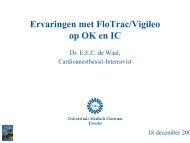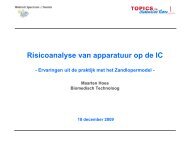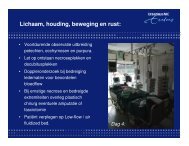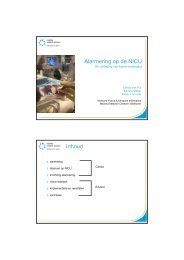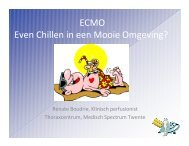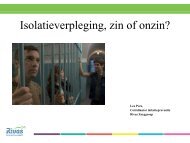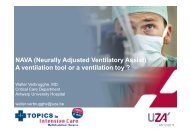Abstract 1 - Topics in Intensive Care
Abstract 1 - Topics in Intensive Care
Abstract 1 - Topics in Intensive Care
Create successful ePaper yourself
Turn your PDF publications into a flip-book with our unique Google optimized e-Paper software.
Manual Hyper<strong>in</strong>flation Attenuates Reduction of Functional Residual Capacity <strong>in</strong><br />
Cardiac Surgical Patients – A Randomized Controlled Trial –<br />
Frederique Paulus 1 , Denise P Veelo 1,2 , Selma B. de Nijs 3 , Ludo F.M. Beenen 4 , Paul Bresser 3,6 , Bas<br />
A.J.M. de Mol 5 , Jan M. B<strong>in</strong>nekade 1 , Marcus J. Schultz 1<br />
Academic Medical Center, University of Amsterdam, Amsterdam, the Netherlands<br />
1 2 3 4<br />
Department of <strong>Intensive</strong> <strong>Care</strong> Medic<strong>in</strong>e Department of Anesthesiology Department of Respiratory Medic<strong>in</strong>e Department of<br />
Radiology 5 Department of Cardiothoracic Surgery.<br />
Onze Lieve Vrouwe Gasthuis, Amsterdam, the Netherlands 6 Department of Respiratory Medic<strong>in</strong>e<br />
Background. Cardiac surgical patients show deterioration of functional residual capacity (FRC) after<br />
surgery. Manual hyper<strong>in</strong>flation (MH) aims at prevent<strong>in</strong>g airway plugg<strong>in</strong>g, and as such could prevent<br />
the reduction of FRC after surgery. The purpose of this study was to determ<strong>in</strong>e the effect of MH on<br />
FRC <strong>in</strong> cardiac surgical patients.<br />
Methods This was a randomized controlled trial of patients after elective coronary artery bypass graft<br />
and/or valve surgery admitted to the <strong>in</strong>tensive care unit of a university hospital. Patients were<br />
randomly allocated to “rout<strong>in</strong>e MH strategy” (MH with<strong>in</strong> 30 m<strong>in</strong>utes after arrival <strong>in</strong> the ICU and every 6<br />
hours until tracheal extubation) or “on demand MH” (MH only <strong>in</strong> cases of perceptible (audible) sputum<br />
<strong>in</strong> the larger airways or <strong>in</strong> case of a drop <strong>in</strong> SpO2.) dur<strong>in</strong>g mechanical ventilation. The primary endpo<strong>in</strong>t<br />
was the change of FRC from the day before cardiac surgery to 1, 3, and 5 days after tracheal<br />
extubation. Secondary endpo<strong>in</strong>ts were SpO2, on the same time po<strong>in</strong>ts, and chest radiograph<br />
abnormalities at day 3.<br />
Results: Hundred patients were enrolled. In the rout<strong>in</strong>e MH group FRC decreased to 72% of the pre–<br />
operative measurement, versus 59% <strong>in</strong> the on demand MH group (P = 0.002). Differences <strong>in</strong> FRC<br />
were not longer statistically significant at day 5(Figure 1). There were no differences <strong>in</strong> SpO2 between<br />
the 2 groups. Chest radiographs showed more abnormalities <strong>in</strong> the on demand MH group compared to<br />
patients <strong>in</strong> the rout<strong>in</strong>e MH group (P = 0.002).<br />
Conclusion: MH attenuates the reduction of FRC <strong>in</strong> the first 3 post–operative after cardiac surgery.<br />
3500<br />
3250<br />
3000<br />
2750<br />
2500<br />
2250<br />
2000<br />
1750<br />
1500<br />
Figure 2<br />
FRC (L)<br />
Preop day 1 PO day 3 PO day 5 PO<br />
Graphical displays of pulmonary function measurements. Preoperative functional residual capacity (FRC (L) mean 95% CI) and<br />
FRC at 1, 3, and 5 days after extubation <strong>in</strong> the rout<strong>in</strong>e MH group (closed circles), and <strong>in</strong> the on demand MH group (open circles)<br />
<strong>Abstract</strong> 22



